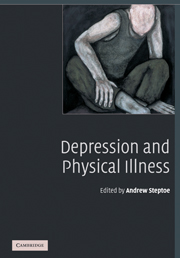Book contents
- Frontmatter
- Contents
- List of contributors
- Preface
- Part 1 Introduction to depression and its determinants
- Part 2 Depression and specific health problems
- 3 Depression and the development of coronary heart disease
- 4 Depression and prognosis in cardiac patients
- 5 The management of depression in patients with coronary heart disease
- 6 Depression and physical disability
- 7 Chronic pain and depression: twin burdens of adaptation
- 8 The interrelationship of depression and diabetes
- 9 Depression and chronic fatigue
- 10 Cancer and depression
- 11 Depression and obesity
- Part 3 Biological and behavioural processes
- Part 4 Conclusions
- Index
- References
10 - Cancer and depression
from Part 2 - Depression and specific health problems
Published online by Cambridge University Press: 17 September 2009
- Frontmatter
- Contents
- List of contributors
- Preface
- Part 1 Introduction to depression and its determinants
- Part 2 Depression and specific health problems
- 3 Depression and the development of coronary heart disease
- 4 Depression and prognosis in cardiac patients
- 5 The management of depression in patients with coronary heart disease
- 6 Depression and physical disability
- 7 Chronic pain and depression: twin burdens of adaptation
- 8 The interrelationship of depression and diabetes
- 9 Depression and chronic fatigue
- 10 Cancer and depression
- 11 Depression and obesity
- Part 3 Biological and behavioural processes
- Part 4 Conclusions
- Index
- References
Summary
Introduction
Recent advances in the detection [1] and treatment [2] of cancer have led to longer survival times [3]; for example, the five-year survival rate of localised breast cancer is now 97% [4]. As a result of this lengthened life expectancy, greater attention is being paid to quality of life and psychosocial care for cancer patients. In the short term, this means ensuring that patients maintain their quality of life during diagnostic and treatment phases. In the longer term, the aim is to ensure that psychological problems are prevented or ameliorated so that cancer patients can rehabilitate and resume functioning at the level they maintained before their cancer.
Cancer remains a life-threatening illness linked by many authors with fears about incapacity, disfigurement and death [5, 6]. Unsurprisingly, many individuals diagnosed with cancer experience at least transient psychological distress. This recognition, however, can lead to a dismissal of depression as a normative response to cancer and missed opportunities to address a highly impairing, but readily treatable, psychiatric disorder when depression does occur. On the other hand, overestimation of the extent to which cancer results in depression can misguide allocation of resources, leading to an emphasis on strategies for aggressively detecting psychiatric disorders at the expense of follow-up care for patients who have already been identified, as well as attention to more common problems and basic supportive needs that affect quality of life among cancer patients more generally.
- Type
- Chapter
- Information
- Depression and Physical Illness , pp. 211 - 237Publisher: Cambridge University PressPrint publication year: 2006
References
- 8
- Cited by

